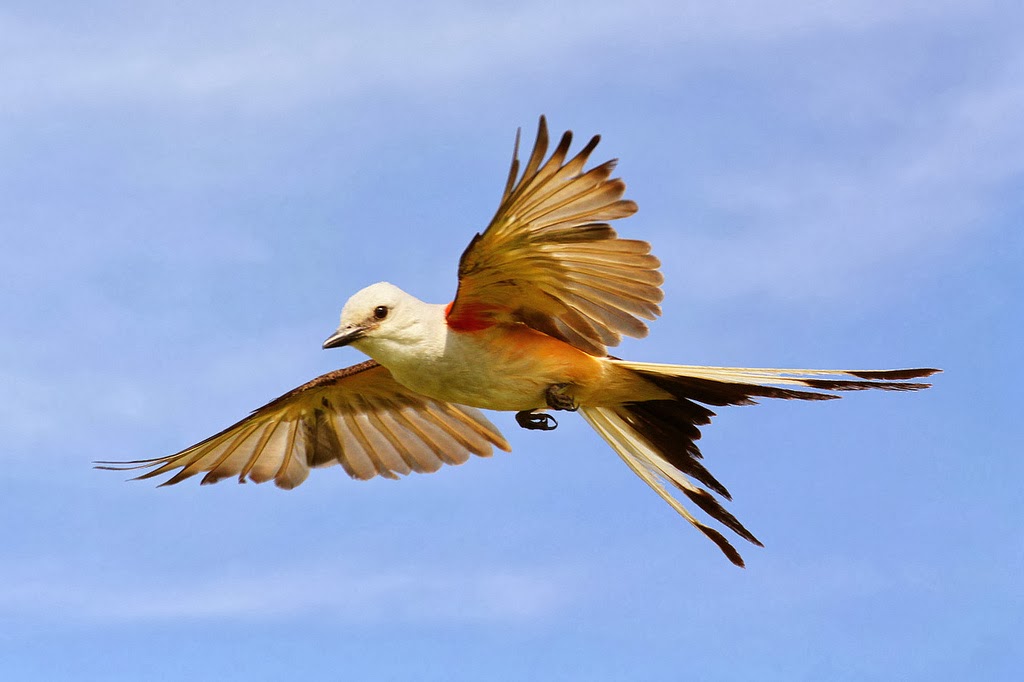Before we get to setting the exposure part let us first discuss a few situations that lets you capture beautifully lit pictures of birds in flight.
 |
| Photo by: Allan Hopkins |
As a general rule pictures of birds in flight turn out great when shooting on sunny days than when shooting when there’s lot of cloud cover (read cloudy days).
Select days with bright blue skies for shooting. Ideal conditions for shooting birds in flight are when there is a bright blue sky; the sun is behind you and is low in the sky (during early mornings and late evenings).
During those times the birds are lit from sunlight coming more from the side than directly from the top which somewhat silhouettes the birds. Sun being low in the sky also cures one another problem; of having not enough light on the underside of the birds wings. Try to shoot your birds with wings up which allow the sun to illuminate the underside of the bird beautifully.
 |
| Photo by: Pat Gaines |
Another important thing to remember is that birds look great when they are illuminated from the front. Pictures in which the tail of the bird is brighter than its head are rather unappealing. In some cases the wings even cast a shadow on the head completely ruining the shot. Therefore whenever possible photograph the bird when it is illuminated from the front.
For example.
If a bird is flying from left to right of your frame the sun should be behind you and more towards the back of your right shoulder.
Tips for Setting Exposure for Shooting Birds in Flight
 |
| Photo by: Ken Slade |
When photographing birds flying fast against varied background elements, exposure settings could change dramatically and it could easily confuse your camera. Best solution is to use spot metering mode to take your reading off the bird and shoot in Manual Mode. This allows you to expose your birds correctly every time irrespective of the changing backgrounds. Remember the illumination on the bird actually does not change much with changing backgrounds.
Now for those of you who primarily shoot in semi automatic metering modes; you will need to set adequate exposure compensation settings depending upon the scene in front of you. Here we will discuss some of the most commonly encountered situations.
Photographing Birds flying against a Bright Sky
 |
| Photo by: Ken Slade |
When photographing birds against a bright sky, you will need to set a positive (+) exposure compensation of 1 or 2 stops to prevent the bird getting underexposed. The amount of exposure compensation needed will vary depending on many factors.
First consideration is how large is the bird in your frame, is the bird almost filling your frame or is it just a tiny dot. If it mostly fills the frame then you need only make minor adjustments to the exposure that your camera suggests and if it is only fills a small percentage then you need to dial in more compensation.
Second consideration is the color of the bird; if you are photographing a white bird against a bright sky you will need more corrections than when photographing a black (or any dark shade) bird. Also take into consideration the first point (How much of your frame is occupied by the bird).
Photographing Birds Flying against a Blue Sky
 |
| Photo by: Isidro Vila Verde |
When photographing white birds flying against a blue sky (which is a mid tone value) you will need to dial in some negative (-) exposure compensation to prevent blowing highlights on the bird.
Breaking all Rules
 |
| Photo by: Nathan Rupert |
Photography is an art and as artists photographers have full creative freedom. Feel free to experiment, break all the rules, try capturing your birds backlit (shoot towards the sun) you could get some very interesting pictures of backlit birds or going further silhouetted bird images against colorful skies.
Related Reading
- Bird Photography Tips - Using Monopods, Tripods and other types of supports
- Photographing Birds in Flight – Master Focusing Technique
- Photographing Birds in Flight – Master Focusing Technique Part II
- Tips for Photographing Shorebirds
- How to Photograph Birds in Flight Using Manual Focus Lenses